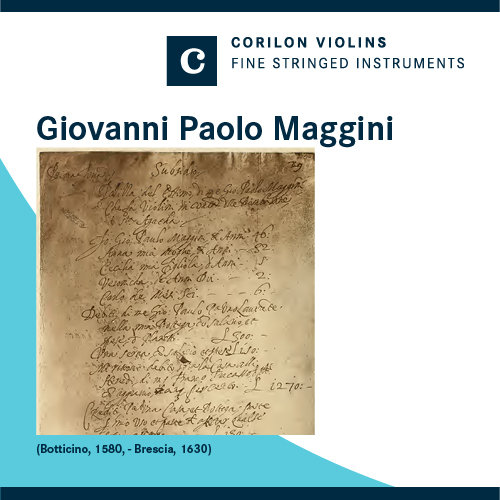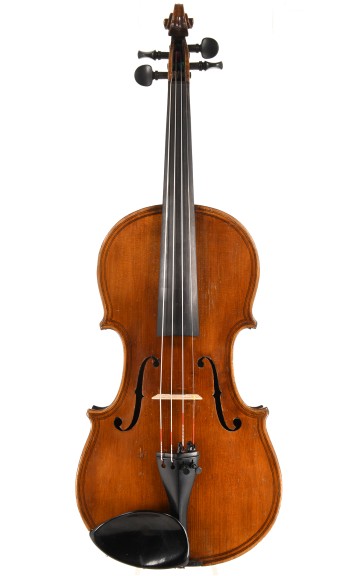Violin maker Giovanni Paolo Maggini (1580 - 1632) is one of the influential historical figures in early Italian violin making and, along with his teacher Gasparo da Salò, the second great master of the Brescia school.
Overview:
- Maggini and early Italian violin making.
- G. P. Maggini as a student of Gasparo da Salò
- Epochs of the work biography of G. P. Maggini
- Giovanni Paolo Maggini's death and legacy
Maggini and early Italian violin making
Giovanni Paolo Maggini was born in 1580 in the Lombard town of Botticino di Sera near Brescia. As a boy of barely 8 years old, he left the modest circumstances of his parental home to learn the violin making trade from Gasparo da Salò - and eventually become one of the most important masters of his time himself. Maggini's remarkable development, his obvious success in the musical world of the early 17th century and his fame that continues to this day are characteristic of this epoch in the history of musical instruments, in which the violin began to emancipate itself from its late medieval predecessors, the viols and the instruments of the viola da braccio family, to finally find in the work of the Cremonese Antonio Stradivari the fundamental definition of its construction principles that are still valid today. 
Fueled by the burgeoning musical culture of the early Baroque period, violin making offered talented craftsmen such as G. P. Maggini and his teacher Gasparo da Salò, one of the earliest known violin makers in the narrower sense of the word, the prospect of making a living so substantial that they had ample scope for the experiments that allowed the violin model to mature within a few decades - which encouraged the demand for even better and even more magnificently appointed stringed instruments all the more.
G. P. Maggini as a pupil of Gasparo da Salò
In 1588, at a young age, Maggini came as an apprentice to the long-established Gasparo Bertolotti, known as da Salò, whose Brescian workshop was famous beyond the borders of Italy for its innovative, beautiful-sounding instruments. Why this profession was chosen for the boy and who opened the door for him to train in this renowned house is not known. We do know, however, that Maggini remained with da Salò until he was 21 years old, during which time he received one of the best educations a liutaio of his time could wish for.
Epochs of the work biography of G. P. Maggini
As an apprentice and collaborator of da Salò, Giovanni Paolo Maggini was naturally bound to the master's procedures and specifications, but even the first phase of his independent work is still clearly influenced by his teacher's violin model. One will not be doing the young master Maggini too much injustice if one sees this as a thoroughly pragmatic decision - after all, da Salò's model was well established on the international market; and the fact that G. P. Maggini did not take too much care with the choice of wood and the constructional details at this time probably does not speak for a lack of training or talent, but rather for a certain pragmatism with which he built up his economic existence.
Initial experiments with different woods, including unusual materials such as poplar, sycamore, walnut, and pear, herald the second phase in his work, in which Maggini worked on a comprehensive reformulation of the violin as a still-young type of instrument. Lavishly decorated works with magnificent inlays, some made of mother-of-pearl and ivory, stand for the aesthetic further development of G. P. Maggini's art, while a comparatively large violin model, initially higher arched and later flatter again, represents his great interest in a more powerful tone.
From these experiments and an assumed close study of works by the Amati family in Cremona - Maggini was a contemporary of the great Nicolà Amati, 16 years his senior, and thus occupies an interesting intermediary position between the generations, if only biographically - the mature Maggini violin with its low ribs, elongated sound holes of an unmistakable shape and the often double purfling, which was to become an often copied feature of his style among later violin makers, finally resulted. More crucial to the sound of these violins, however, is that over the years Maggini had studied, calculated, and optimized in detail the proper distribution of top and back thickness.
Giovanni Paolo Maggini's death and legacy
When G. P. Maggini fell victim to the plague in 1632, his workshop was presumably taken over by Santo de Santis, a friend, who continued it from then on under the name "Pietro Santo Maggini" and was long thought in the literature to be a son of Maggini. Among the unanswered questions of the Maggini legacy is the extent to which Pietro Santo, a skilled carpenter, built instruments himself - or whether he had access to a more extensive legacy of finished or semi-finished work.
While the immediate impact of Giovanni Paolo Maggini on subsequent generations is largely obscure, as none of his students achieved preeminent importance, research nevertheless assumes that Maggini's work more than marginally influenced the work of Cremonese "competitors" Andrea Guarneri - grandfather of the famous del Gesù - and Antonio Stradivari. Like most of the old Italian classics, Giovanni Paolo Maggini was initially forgotten when Jakob Stainer's violin model exerted its dominant influence on the Baroque era, but found a new appreciation with the return to the Lombard roots of violin making, which was expressed not least in frequent imitations of Maggini's unique ornamentation since the early 19th century.




